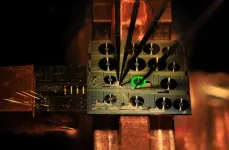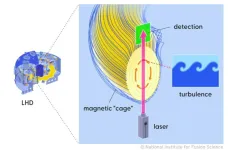(Press-News.org)
Lasers have revolutionized the world since the 60’s and are now indispensable in modern applications, from cutting-edge surgery and precise manufacturing to data transmission across optical fibers.
But as the need for laser-based applications grows, so do challenges. For example, there is a growing market for fiber lasers, which are currently used in industrial cutting, welding, and marking applications.
Fiber lasers use an optical fiber doped with rare-earth elements (erbium, ytterbium, neodymium etc) as their optical gain source (the part that produces the laser’s light). They emit high-quality beams, they have high power output, and they are efficient, low-maintenance, durable, and they are typically smaller than gas lasers. Fiber lasers are also the ‘gold standard’ for low phase noise, meaning that their beams remain stable over time.
But despite all that, there is a growing demand for miniaturizing fiber lasers on a chip-scale level. Erbium-based fiber lasers are especially interesting, as they meet all the requirements for maintaining a laser’s high coherence and stability. But miniaturizing them has been met by challenges in maintaining their performance at small scales.
Now, scientists led by Dr Yang Liu and Professor Tobias Kippenberg at EPFL have built the first ever chip-integrated erbium-doped waveguide laser that approaches the performance with fiber-based lasers, combining wide wavelength tunability with the practicality of chip-scale photonic integration. The breakthrough is published in Nature Photonics.
Building a chip-scale laser
The researchers developed their chip-scale erbium laser using a state-of-the-art fabrication process. They began by constructing a meter-long, on-chip optical cavity (a set of mirrors that provide optical feedback) based on ultralow-loss silicon nitride photonic integrated circuit.
“We were able to design the laser cavity to be meter-scale in length despite the compact chip size, thanks to the integration of these microring resonators that effectively extend the optical path without physically enlarging the device,” says Dr. Liu.
The team then implanted the circuit with high-concentration erbium ions to selectively create the active gain medium necessary for lasing. Finally, they integrated the citcuit with a III-V semiconductor pump laser to excite the erbium ions to enable them to emit light and produce the laser beam.
To refine the laser’s performance and achieve precise wavelength control, the researchers engineered an innovative intra-cavity design featuring microring-based Vernier filters, a type of optical filter that can select specific frequencies of light.
The filters allow for dynamic tuning of the laser's wavelength over a broad range, making it versatile and usable in various applications. This design supports stable, single-mode lasing with an impressively narrow intrinsic linewidth of just 50 Hz.
It also allows for significant side mode suppression – the laser’s ability to emit light at a single, consistent frequency while minimizing the intensity of other frequencies (‘side modes’). This ensures “clean” and stable output across the light spectrum for high-precision applications.
Power, precision, stability, and low noise
The chip-scale erbium-based fiber laser features output power exceeding 10 mW and a side mode suppression ratio greater than 70 dB, outperforming many conventional systems.
It also has a very narrow linewidth, which means the light it emits is very pure and steady, which is important for coherent applications such as sensing, gyroscopes, LiDAR, and optical frequency metrology.
The microring-based Vernier filter gives the laser broad wavelength tunability across 40 nm within the C- and L-bands (ranges of wavelengths used in telecommunications), surpassing legacy fiber lasers in both tuning and low spectral spurs metrics (“spurs” are unwanted frequencies), while remaining compatible with current semiconductor manufacturing processes.
Next-generation lasers
Miniaturizing and integrating erbium fiber lasers into chip-scale devices can reduce their overall costs, making them accessible for portable and highly integrated systems across telecommunications, medical diagnostics, and consumer electronics.
It can also scale down optical technologies in various other applications, such as LiDAR, microwave photonics, optical frequency synthesis, and free-space communications.
“The application areas of such a new class of erbium-doped integrated lasers are virtually unlimited,” says Liu.
The lab spin-off, EDWATEC SA, is an Integrated Device Manufacturer that can now offer Rare-Earth Ion-Doped Photonic Integrated Circuit-based Devices including high-performance amplifiers and lasers.
Other contributors
EPFL Center for Quantum Science and Engineering
Reference
Yang Liu, Zheru Qiu, Xinru Ji, Andrea Bancora, Grigory Lihachev, Johann Riemensberger, Rui Ning Wang, Andrey Voloshin, Tobias J. Kippenberg. A fully hybrid integrated Erbium-based laser. Nature Photonics 10 June 2024. DOI: 10.1038/s41566-024-01454-7
END
ROCKVILLE, Md.— New research reveals that moderate to vigorous physical activity in the evening for sedentary adults with overweight and obesity is most beneficial in lowering daily blood sugar levels, according to a study published in Obesity, The Obesity Society’s (TOS) flagship journal.
Experts explain that it has been well established that moderate to vigorous physical activity enhances glucose homeostasis in adults with overweight and obesity who are at higher risk of developing insulin resistance. ...
ROCKVILLE, Md.— Individuals treated with anti-obesity medications generally experience reduced appetite, which typically leads to reduced food intake. As a result, dietary quality becomes more important because nutritional needs must be met within the context of eating less. To improve this process, medical experts have developed a list of evidence-based nutritional recommendations to assist clinicians treating patients with anti-obesity medications, according to a review published in the journal Obesity, The Obesity Society’s (TOS) flagship journal.
“Our evidence-based review aims to equip clinicians with knowledge ...
Boys are good at math, girls not so much? A study from the University of Zurich has analyzed the social mechanisms that contribute to the gender gap in math confidence. While peer comparisons seem to play a crucial role for boys, girls’ subjective evaluations are more likely to be based on objective performance.
Research has shown that in Western societies, the average secondary school girl has less confidence in her mathematical abilities than the average boy of the same age. At the same time, no significant difference ...
Carbon capture and utilization technologies for the conversion of carbon dioxide into carboxylic acids have garnered attention recently, with researchers from Tokyo Tech recently demonstrating a biocatalyzed carboxylation reaction of not only natural substrate, pyruvate, but also unnatural one, 2-ketoglutarate, using Thermoplasma acidophilum NADP+- malic enzyme under mild reaction conditions. The proposed strategy can be tailored for the selective synthesis through carbon dioxide fixation reactions.
Removing the excess carbon dioxide (CO2) from the environment is not the end goal of the decarbonization process necessary to ...
Among US veterans diagnosed with lung cancer through the Veterans Health Administration healthcare system, those who underwent screening before diagnosis were more likely to be diagnosed with earlier stage disease and had a higher cure rate than those who had not been screened. The findings come from an observational study published by Wiley online in CANCER, a peer-reviewed journal of the American Cancer Society.
Lung cancer is the leading cause of cancer deaths worldwide, and most patients are diagnosed at ...
Peer-reviewed – Observational study - People
Adolescents who experience higher levels of social anxiety symptoms are more likely to report increased suicidal thoughts and other depressive symptoms two years later, according to new research.
The University of East Anglia-led study sheds light on the pressing need for early interventions to address society anxiety in young people.
Lead author Dr Kenny Chiu, Clinical Lecturer in Clinical Psychology at UEA’s Department of Clinical Psychology and Psychological Therapies, said: “Social Anxiety Disorder ...
Abnormal blood flow in the aorta is linked to inflammation and breakdown of the vessel wall in conditions where the aorta is dilated. This is shown in a study led by researchers at Linköping University. The findings can contribute to better diagnosis and open up new ways to assess the risk of serious and usually fatal complications, such as rupture of the aorta.
All blood in the body passes through the heart about once a minute. With every heartbeat, blood from the heart is pumped up into the aorta.
Dilation can occur in all parts ...
Health services should teach patients with eating disorders psychosocial skills to help more people recover and avoid relapse, according to an expert.
Anorexia, bulimia and other eating issues affect millions of people, and eating disorder specialist Bethany Crowley warns that eating disorders are often misunderstood. She suggests a more integrated approach to treating people is needed, to focus on the whole person rather than just the disordered eating.
Quieting negative thoughts, learning to cope with emotional triggers and practicing self-compassion are among nine key skills outlined by the therapist in a new book.
An Integrative Approach to Treating Eating ...
Background
Fusion energy is that released when two light nuclei combine to form a single heavier one (nuclear fusion reaction). Fusion energy-based power generation (fusion power plant) uses the energy generated when deuterium and tritium combine to form helium. A nuclear fusion reaction does not produce carbon dioxide. In addition, since it is possible to extract deuterium and tritium from the sea water, fusion energy is regarded as a sustainable energy source, and research into its practical application has been progressing rapidly ...
A glowing marker dye that sticks to prostate cancer cells could help surgeons to remove them in real-time, according to a study funded by Cancer Research UK.
Cancer Research UK-funded scientists, based at the Nuffield Department of Surgical Sciences and the Department of Oncology, University of Oxford, Oxford University Hospitals and Oxford NIHR Biomedical Research Centre used a fluorescent dye attached to a special marker molecule to give medics a “second pair of eyes” during surgery for prostate cancer.
Twenty-three men with prostate cancer were injected with the marker dye before undergoing prostate removal surgery. The marker dye found areas of cancerous tissue ...





